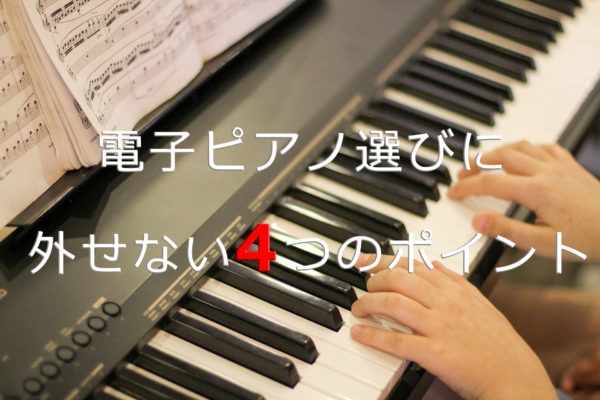
ほとんどの人は本物のピアノ(アップライトピアノやグランドピアノ)を持っていたいですよね。
しかし、価格やスペース、メンテナンスなどの問題からなかなかピアノに手が出ない方は多いことでしょう。
そういうときは電子ピアノの方が実用的で安価なため、初心者の方の選択肢として入ってきますね。
特に近年の電子ピアノの技術の進化はすごいもので、デジタルなのに本物のピアノと間違えるような音質や響き方、まるで(ハンマーを使った)ピアノの鍵盤を弾いているようなタッチなど、かなり本物のピアノに近づいているように感じます。
また初心者にとって、電子ピアノはピアノよりもおすすめな理由があります。
やる前まではやる気満々だったのに、いざやってみると意外と楽しめなくて長続きしないことってありますよね。同じようにピアノ初心者や未経験者は、ピアノをある程度弾けるようになるまで、飽きずに楽しみ続ける保証はありません。そう言った意味でもキーボードはピアノよりも安価であり、初心者にオススメな楽器と言えるでしょう。
また、録音やメトロノームの機能など、初心者の練習を補助する機能が多く備え付けられているのも理由の一つです。
しかし、キーボードがピアノよりも安いとはいえ、家計的には高い買い物になることは間違いありません。
今回はお金を無駄にしないためにもキーボードを選ぶ上で、最低限必要の知識とポイントをご紹介します。
チェックするべき4つのポイント
今回ご紹介するのは4つのポイントです。
本当はもっと詳しくお話ししたいポイントもあるのですが、あまり多すぎると商品を選べなくなってしまいます。
初心者にとって「そんな機能どうでもいいよ」と言われるようなことを紹介しても意味がありませんから、厳選して4つだけご紹介します。
1、鍵盤がフルサイズであること
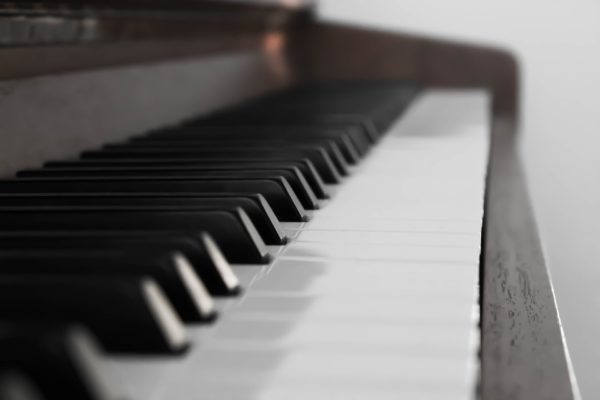
電子ピアノの鍵盤も本物のピアノと同じ数であるべきです。
いわゆる「普通のピアノ」というのは【88鍵盤】で7オクターブの音域に対応しています。
1つ目のポイントとして、正しい指の間隔とピアノの音階を習得するためにも、「電子ピアノの鍵盤の数」は確認するようにしてください。
電子ピアノをおもちゃの1つとして使う場合は、関係ありませんし、多くの初心者用の楽譜というのはこの半分の鍵盤があれば十分に演奏できるものばかりです。
しかし、将来的にピアノを極めてみたいと思ったり、少し難しい曲を演奏したいと思った時にもっている電子ピアノの鍵盤の数がピアノのそれと違っていたら、かなり無駄な買い物をしてしまうことになります。
演奏できる曲(楽譜)だけではなく、「正しい姿勢」を身につけるためにも鍵盤の数はフルサイズのものを押さえておくことをオススメします。
低い音や高い音を演奏する時に、腕の伸ばし方・力の使い方というのを感覚的に習得しておくことで、将来ピアノを演奏することになった時にも対応が簡単になります。
まずは鍵盤の数を確認するようにしましょう。
2、ピアノに近い、重みのある鍵盤であること
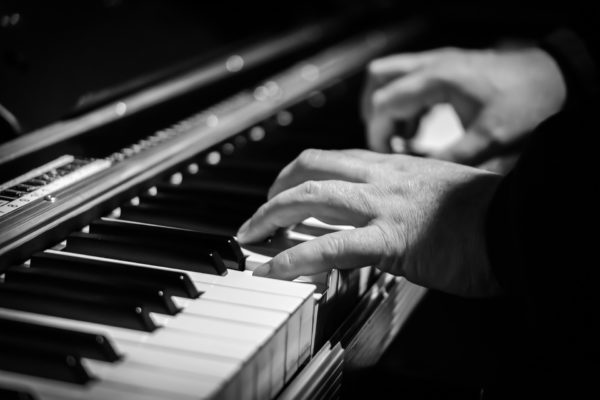
タッチが本物に近いことはとても重要なことです。
楽器屋さんで子供用のキーボードとグランドピアノ(アップライトピアノ)の鍵盤を押し比べてみればすぐに分かりますが、ピアノの鍵盤というのは押すためにやや力が必要なほど重いのが特徴です。
キーボードにはこの重みは備わっていません。
重みがないキーボードで練習していても、ピアノを演奏してみるとその重さの違いからぎこちない演奏になってしまいます。そのためキーボードでの練習は、(全くではないですが)ピアノの練習にはならないのです。
2つ目のポイントは「鍵盤に重みを持っていること」です。
ヤマハやカワイを始め、電子ピアノの各メーカーはこの重みであるタッチをできるだけ本物のピアノに近づけるよう追求し、様々な種類の電子ピアノの鍵盤を作っています。
例えばヤマハであれば、「 GHS(グレードハンマースタンダード)鍵盤 」や「NWX(ナチュラルウッド エックス)鍵盤」、カワイであれば「 GFSアクション鍵盤 」などです。
グランドピアノやアップライトピアノも種類によってタッチの差があるため、ここではどの鍵盤がいいかは触れませんが、これらのようにタッチに一定の重みをもつ電子ピアノを選びましょう。
そういった電子ピアノで演奏することで指の力やテクニックを鍛えることができ、あなたが本物のピアノを演奏しても簡単に馴染ませることができるでしょう。
3、タッチ感度を認識していること
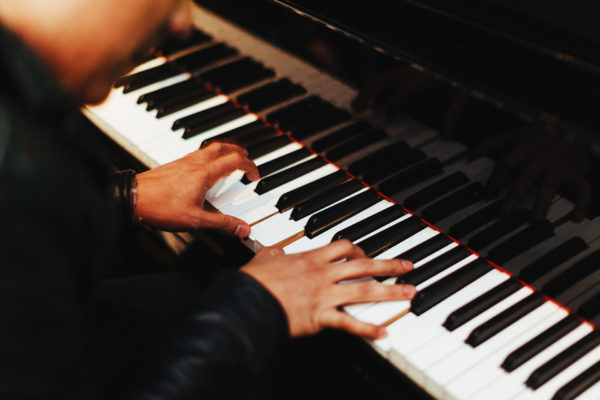
「タッチ感度」と書きましたが、これは鍵盤を弾く強さや弱さ、速さといったものです。
3つ目のポイントとして、これらを電子ピアノが認識して、「タッチに応じた音が出てくる電子ピアノ」を選びましょう。
よくある特に昔の安い電子ピアノでは、この機能がありません。
強く鍵盤を押しても、ゆっくりやさしく鍵盤を押しても、同じ大きさで音が出てしまうのです。
このようなピアノで練習を重ねると細かい強弱の付け方が分からなくなり、いざアップライトピアノやグランドピアノを演奏してみると、とても下手くそな音色になってしまいます。
この機能はメーカーによって呼び名が少し違います。
例えばローランドであれば「ハンマー・レスポンス機能」といった名前で記載されているのです。
目ぼしい電子ピアノがあれば、その仕様を細かく見て、タッチ感度を認識する機能があり、できればその精度が高いものを選びましょう。
4、不要な機能をもっていないこと

これは一見当たり前のことのように聞こえるかもしれませんが、とても重要です。
4つ目のポイントとして「無駄な機能を電子ピアノを選ぶ基準にしない」ようにしましょう。
電子ピアノは高ければ良いというものではありません。
シンセサイザーには様々な効果を演奏に付け加えることができ、また多くの楽器の音を演奏することができます。
これらの機能の一部は、特に高い電子ピアノにも備わっていることが多いです。
例えば、フルートの音をキーボードで再現できる機能があったとしましょう。
はたしてその機能は、あなたのピアノの練習や楽しみ方において必要な機能ですか?
他にも、変調して(音の高さを変えて)弾いている鍵盤の音よりも少し高い音をスピーカーから出す機能は必要ですか?
キーボードを買う理由が、ピアノの練習や演奏ではなく、作曲や一人でオーケストラを演奏するような場合にはこれらの機能は必要になるでしょう。
しかし、ピアノの代替として電子ピアノを買うのであればこれらの機能は不要です。
特に初心者にとってこれらの追加機能というのは、混乱を招き、気を散らす原因になることがあります。
もちろんこれらの機能は電子ピアノの値段に反映されています。
無駄なお金を使わないためにも、あなたにとって無駄な機能をもつ電子ピアノを購入しないようにしましょう。
逆に必要な付随機能、例えば「メトロノーム」なんかは付いていると大変便利ですので、そういった機能は惜しまず選ぶ一つの基準にしてもいいでしょう。
さいごに
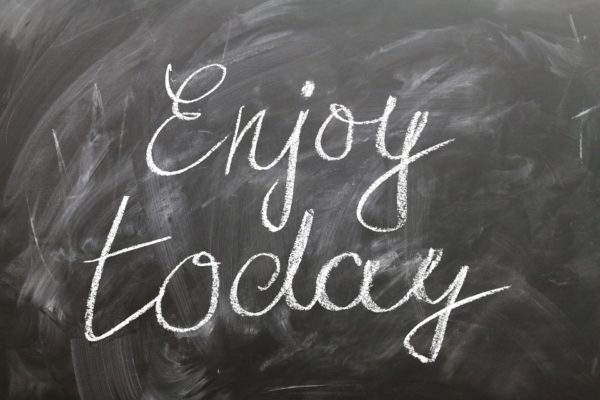
私は幸運なことに、実家に叔母が昔使っていたアップライトピアノがあったので、はじめの頃はそれを使って練習をしていました。
しかし、親元を離れた今では、電子ピアノ(ヤマハのグラビノーバ)を使っています。
最初にも述べたように、最近の電子ピアノはピアノをよく再現してあります。
ときどき実家に帰ってアップライトピアノを演奏しますが、全くと言っていいほど違和感なく演奏することができます。
今回のチェックリストのことをしっかり把握して電子ピアノを選べば、本物のピアノの演奏でも同じように演奏することができるはずです。
はじめの練習は大変で、面白くないものかもしれませんが、その先には色んな曲を弾ける自分がいるはずです。
ぜひ楽しいピアノライフをお過ごしください。

コメントを残す